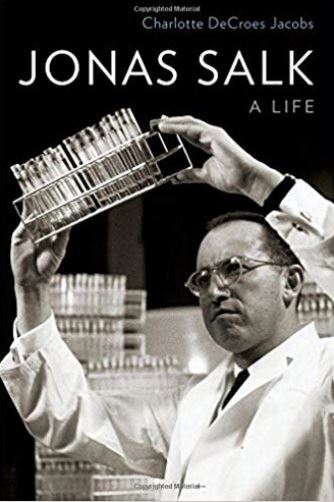 Founded in 1980 |
|
| Charlotte DeCroes Jacobs, Jonas Salk: A Life, New York, Oxford University Press, 2015, ISBN 978-0-19-933441-4. |
June 28, 2017
The name of Jonas Salk immediately conveys to mind the one who is credited with bringing to an end the terror of polio during the middle of the last century. Those of us of a certain age recall, as children, playmates who “disappeared,” summers during which we were forbidden to attend movies or cool off in the neighborhood swimming pool, and the threat of becoming ill and being confined in an “iron lung.”
So it was that in the mid-1950s the realization that the scourge of polio would be defeated by the introduction of an amazing vaccine brought immense relief to children and adults and everlasting fame and glory to a young, shy, and seriously-minded scientist—Salk—whose life was forever altered and whose later accomplishments perhaps measured against this early success.
The stirring backstory of Jonas Salk is here explored in depth and brought to life by the skilled pen of Charlotte Jacobs, who, through extensive research and dozens of interviews, casts Salk as a fascinating, strong-willed, and multifaceted individual who is nevertheless haunted by detractors and fellow investigators possibly motivated, in part, by professional envy.
While Salk’s reputation is widely hailed for his development of the first successful killed virus vaccine for polio, Jacobs reminds us that it was Salk who first introduced a successful influenza vaccine, inoculating thousands of psychiatric patients and combat troops in the early 1940s. Later, he experimented with myelin basic protein for the treatment of multiple sclerosis; while showing early promise, success was limited by adverse hypersensitivity reactions. In the 1980s, Salk turned his attention to the development of an innovative therapeutic vaccine to combat AIDS.
Motivated by his vision of himself as destined to “repair the world” (tikkun olam), Salk sought to meld the fields of science and humanities in the establishment of an institute where scientists could work and study in an idealized, creative environment, unimpeded by distracting influences. Although falling short of his full intention, the Institute, which bears his name, remains today a leading institution for investigation in neuroscience, genetics, and immunology.
Jacobs’ writing is sensitive, compelling, and masterful. Beginning with polio’s historical background, she describes Salk’s early life and the somewhat convoluted path—his mother had encouraged him to become a lawyer—to a career in medicine and immunology. It was as a medical student that he was attracted to laboratory research, learning that a killed virus could impart immunity. Later, Salk tried to initiate a friendship and professional collaboration with Albert Sabin, who developed a live, attenuated polio vaccine, but this relationship subsequently became fraught and their conflict on the matter of live versus killed polio vaccine never satisfactorily resolved. Salk’s ambition, drive, intuition, compassion, trustworthiness, patience, and humor are thoroughly examined and placed into perspective with his personal foibles, which some would label considerable.
A sizable tome, running to 559 pages, the book is nevertheless easy and fun to read. Its thirty-two chapters are each concise, focused, and thorough. Material is suitably well-annotated. In an appended acknowledgement chapter, the author relates how she became personally attracted to the medium of biography and how she developed her talent for it. Her earlier work, Henry Kaplan and the Story of Hodgkin’s Disease, was reviewed here previously; as with Jonas Salk: a Life, Jacobs demonstrates her immense skill at creating a compelling drama of personality, temperament, and character.
